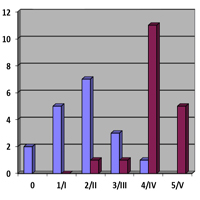Pneumocystis pneumonia in HIV-negative immunocompromised patients in Internal Medicine ward

All claims expressed in this article are solely those of the authors and do not necessarily represent those of their affiliated organizations, or those of the publisher, the editors and the reviewers. Any product that may be evaluated in this article or claim that may be made by its manufacturer is not guaranteed or endorsed by the publisher.
Authors
Pneumocystis jirovecii pneumonia (PJP) is an opportunistic infection typically observed in AIDS patients, for whom it represents a leading cause of death. However, its incidence among HIV-negative immunocompromised patients is progressively increasing, with a significantly higher mortality compared to that of AIDS-patients. We performed a retrospective observational study on HIV-negative patients with PJP. We aimed to determine their epidemiological features and their biohumoral and therapeutic variables, searching for a correlation between them and our patients' outcome. We included all patients admitted to our Internal Medicine ward from January 2010 to June 2015, who were immunocompromised at the time of admission and had microbiologically confirmed PJP (association between compatible clinical-radiological findings and qualitative polymerase chain reaction positivity on bronchoalveolar lavage). Their immune impairment was assessed considering both their medical history and their complete white blood cells (WBC), differential WBC and their CD4 cell count. Transfer to Intensive Care Unit (ICU) or death was considered as an unfavorable clinical outcome, while hospital discharge or transfer to a non-ICU ward was considered as a favorable outcome. We included a total of 18 patients in our statistical analysis. We used Student's t-test and Fischer's χ-square test to compare, respectively, normally distributed continuous variables and non-continuous variables. Our patients' mean age was 65±13.9 years. All of them had cancer, mostly hematological malignancies (13/18), notably non-Hodgkin lymphoma (NHL; 8/13). They were all being or had been recently treated with chemotherapy (10/18) and/or high-dose glucocorticoids, with full dose or during tapering (13/18). Statistical analysis of blood tests results showed a significant difference between mean serum lactate dehydrogenase (LDH) concentration in the group of patients with favorable vs unfavorable outcome. Also, mean serum immunoglobulins G (IgG) concentration and certain arterial blood gas findings (mean arterial paO2/FiO2, mean blood Ph and mean paCO2) at the time of admission were significantly different in the two groups of patients. 12/18 patient's outcome turned out unfavorable. Trimethoprim + sulfamethoxazole (TMP+SMX) treatment was given to all our patients, with a mean duration of 13.39±9.36 days. Patients with a favorable outcome had received TMP+SMX treatment significantly earlier than those with an unfavorable outcome. Hematological malignancies, according to literature, confer the strongest predisposition to PJP. Both chemotherapy and high-dose Glucocorticoid treatment are well known predisposing factors. A remarkable elevation of serum LDH represents both a typical clinical feature and a well-known negative prognostic factor in PJP. Low IgG levels have never been reported as a negative prognostic factor, but their role in enhancing macrophage killing of pneumocystis may account for the worst observed prognosis in the group of patients with lower mean levels. Therefore, in order to reduce the heavy mortality rate associated with PJP, an early beginning of specific treatment is of utmost importance, and even if this is certainly true for many infectious diseases, the time gap is particularly limited in the setting of this type of pneumonia. Hence, PJP should be ruled out as soon as possible and, in case of a strong clinical- radiological suspicion, therapy should be started immediately, even while waiting for microbiological confirmation (especially in critically-ill patients).
How to Cite
PAGEPress has chosen to apply the Creative Commons Attribution NonCommercial 4.0 International License (CC BY-NC 4.0) to all manuscripts to be published.






